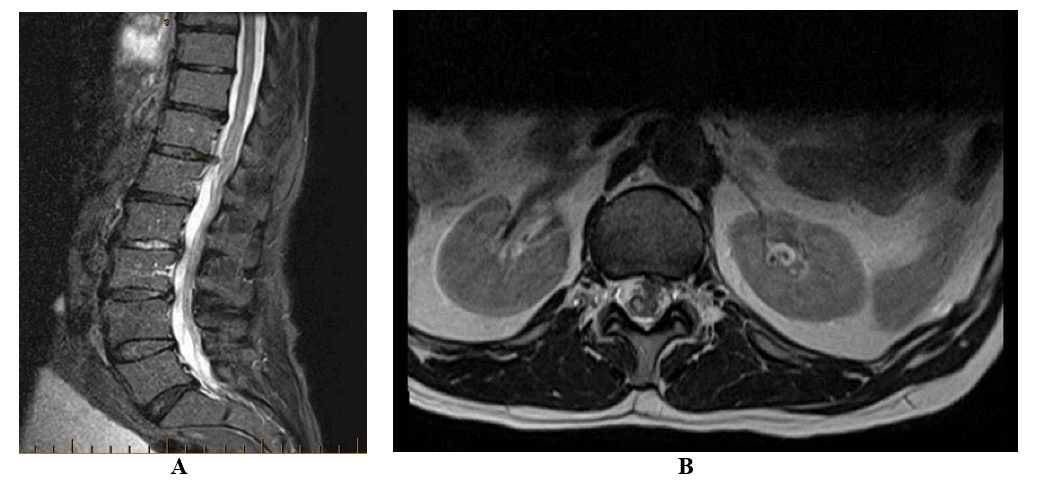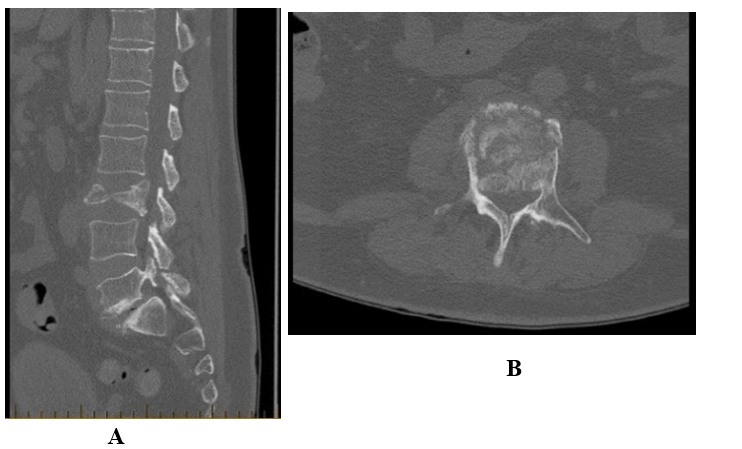COVID-19 Pandemic Morbidity and Mortality Caused to Non-COVID Spine Inpatients at a Level One Trauma Centre: Case Report
A B S T R A C T
Background: Coronavirus disease 2019 (COVID-19) caused by the 2019 novel coronavirus (SARS-CoV-2) is evolving, overwhelming the healthcare system and negatively impacting inpatients, requiring non-elective surgical intervention.
Case Presentation: We present two cases admitted under the Orthopaedic Spine Unit, a patient with an acute T12/L1 disc herniation and new-onset progressive bilateral lower extremity weakness, whose surgery was complicated by a cardiac arrest, secondary to a pulmonary embolism due to delayed access to the operating theatre (OR) and a patient with an L3 burst fracture, who left the hospital after waiting for four days for surgical management, being afraid of becoming infected with COVID-19.
Conclusion: Challenges amid the COVID-19 pandemic are real, but solutions must be explored. Acting on the proposed strategies listed in the report may be a good start towards improving the outcome and helping to avoid unintentional complications.
Keywords
Coronavirus disease 2019, COVID-19, spine surgery
Background
An outbreak of coronavirus disease 2019 (COVID-19) caused by the 2019 novel coronavirus (SARS-CoV-2) began in Wuhan, Hubei Province, China, in December 2019, and has spread throughout the world [1, 2]. The COVID pandemic is overwhelming the public health and healthcare delivery systems in the world. Surgeons have cancelled elective surgeries so that hospitals and medical professionals can prepare for the growing number of coronavirus patients and preserve resources [3-5]. Despite the new policies developed by health authorities in light of this pandemic, there is still a lack of clear guidelines to follow for the care of COVID negative patients requiring timely care with the restraint of limited resources, resulting in clinicians making difficult decisions, and in some instances causing further morbidity and mortality. In this report, we aim to address how the COVID pandemic has caused morbidity resulting from preventable complications to patients admitted to the Orthopaedic Spine Unit and the proposed solutions to overcome them.
Case Presentation I
A 68-year-old male patient, with a diagnosed case of hypothyroidism and benign prostate hyperplasia (BPH), presented with a less-than-24-hour history of acute lower extremity weakness and inability to walk. There were no other red flags. His examination revealed bilateral lower extremity weakness of variant degrees (0-3, as per the ASIA impairment scale) [6]. He otherwise had intact sensation, normal anal tone with intact perianal sensation, downgoing plantar reflexes and no clonus. MRI whole spine showed a T12/L1 central canal occupying disc extrusion, causing severe spinal canal compression at this level and myelomalacia (Figure 1). He tested negative for COVID-19 using a nasopharyngeal swab. The patient was admitted for urgent spinal decompression surgery. However, despite booking the patient for surgery within 4 hours, the surgery was done only 48 hours after his admission because of the shutdown of OR recourses for the COVID pandemic efforts. The surgery went uneventfully, but after transfer to a stretcher and extubation, the patient had a cardiac arrest while still in the operating theatre.
Figure 1: Representative sagittal A) and B) axial T2 MRI of the Thoraco-Lumbar Spine demonstrating a compressive herniated nucleus pulposus at T12/L1.
Figure 2: Representative axial CT chest cuts with contrast demonstrating bilateral multifocal pulmonary emboli at the lobar, segmental and subsegmental levels.
Cardiopulmonary resuscitation (CPR) was started, including prompt reintubation and return of spontaneous circulation (ROSC) was achieved after five minutes. Computed tomographic (CT) pulmonary angiography revealed a massive pulmonary embolism (Figure 2), and the patient was started on therapeutic intravenous (IV) unfractionated heparin. He was not on anticoagulation therapy while awaiting the surgery. He was admitted to the intensive care unit (ICU) for four days and transferred to the hospital floor in good condition.
Case Presentation II
A 68-year-old male patient, with a diagnosed case of diabetes mellitus, hypertension, and dyslipidemia, had a history of a fall and sustained an L3 burst fracture that was managed initially non-operatively with a thoracolumbosacral orthosis (TLSO). He presented to the clinic for his six-week follow-up appointment. Repeated lumbar spine X-rays followed by CT Thoraco-Lumbar spine showed progressive collapse of the fracture with increased retropulsion of the fragment into the spinal canal (Figure 3). In addition, the patient had a new L3 right-sided radiculopathy and progressive difficulty ambulating now using a walker. His neurological exam was otherwise normal. He was counseled and admitted for a minimally invasive posterior spinal fusion L2-L4. He tested negative for COVID-19 using a nasopharyngeal swab. The surgery was postponed three times due to urgent and emergent cases and limited access to the operating theater because of the COVID-19 pandemics. After four days on an emergency list as a priority case to be done in under 12 hours, the patient eventually opted to go home with an unstable fracture and to be followed-up in the clinic. We explained to him and clearly documented the challenges treating emergent spine cases when all efforts were on COVID-19 positive patients. Open communication was maintained, and he reasonably understood the limitations in our ability to provide “standard of care”.
Figure 3: Representative sagittal A) and B) axial CT scan of the Thoraco-Lumbar Spine demonstrating an L3 burst fracture with collapse and retropulsion in the spinal canal.
Discussion
Coronavirus disease 2019 (COVID-19) is one of many competing risks for patients requiring surgical care. In response to the rapidly evolving challenges faced by hospitals related to the COVID-19 outbreak, it was deemed necessary to curtail elective surgical procedures in order to prevent unnecessary patient and staff exposure and to expand healthcare system capacity and conserve personal protective equipment [3-5]. Despite curtailment of elective surgeries, the urgent and emergent surgeries are also delayed as the hospitals are attempting to optimize their logistical capability.
The first patient had suffered from an acute lower extremity neurological deficit, and as per the guidelines, he should have undergone an emergent surgery [7-10]. As a routine measure, surgical patients should not be kept on anticoagulation therapy prior to surgery, unless otherwise indicated, to minimize the risk of bleeding intraoperatively. For our patient, the surgery was repetitively delayed by higher priority cases and limited OR availability. He was not on an anticoagulation therapy, which put him at risk of developing a deep vein thrombosis and subsequent pulmonary embolism, which could have been fatal.
In fact, had this arrest occurred only a few hours prior or later on a surgical ward, COVID-related changes to our hospital’s Code Blue protocols would have almost guaranteed a poor outcome as unwitnessed arrests and asystole are not being resuscitated, CPR is being delayed until intubation, and limited efforts are being made for witnessed PEA that does not respond quickly to ACLS measures. These policies have been implemented to minimize exposure to aerosols generated during CPR and are followed regardless of the patient’s COVID test results, given the risk of false negatives and nosocomial transmission. Our patient had a negative test result the same day as the surgery and was asymptomatic. These changes will no doubt result in fatalities that will not be tallied in the COVID mortality count but are indirectly attributable to the disease.
The second patient should have undergone an urgent surgery as well but again was repetitively delayed by higher priority cases and limited OR availability and ultimately waited for surgery for four days. The patient ultimately left against medical advice (AMA) rather than waiting and risking himself being possibly infected by staying in the hospital amid the COVID-19 pandemic.
Historical guidelines have been created to guide surgical-decision-making and administrative personnel in order to facilitate prioritization of patient’s care [7-10]. However, these guidelines are not very much achievable in the current environment of the pandemic. Beyond opening more operating theatres, options may include a physically separate hospital, exclusively for non-COVID-19 surgical patients requiring immediate surgical interventions. This was the original concept of the USNS Comfort Navy Hospital in NYC, whereby it was originally meant to address the care needs of COVID negative patients only.
Furthermore, there must be a modified consent for patients coming to the hospital for urgent care in the pandemic where open lines of communication between patient and surgeon are transparent, and both sides understand the great strains the system is experiencing to maintain “standard of care” while helping COVID positive patients. This consent form must go as far as saying that within the pandemic era, non-COVID spine inpatient care may be delayed and not at the level expected outside the pandemic period. Not least of all, there should be open communication between the theatre coordinator, surgeons, and anesthetists, on a daily basis, so resource allocation and patient prioritization should be agreed.
Given the uncertainty regarding the impact of COVID-19 over the next days to weeks to months, delaying such urgent surgical cases will continue to increase the morbidity or mortality of COVID negative patients.
Conclusion
The CVOID-19 pandemic is a real challenge, impacting the healthcare systems around the world and all patients’ care. Considering the hospital capacities, addressing the challenges, and acting on the solutions that serve inpatients requiring non-elective surgeries would certainly ameliorate the outcomes and are more cost-effective strategies than treating complications that may ensue due to late intervention.
Consent
Written consent has been provided by the patient to have the case details and images published.
Conflicts of Interest
None.
Article Info
Article Type
Case ReportPublication history
Received: Wed 29, Apr 2020Accepted: Thu 14, May 2020
Published: Fri 22, May 2020
Copyright
© 2023 Humaid Al Farii. This is an open-access article distributed under the terms of the Creative Commons Attribution License, which permits unrestricted use, distribution, and reproduction in any medium, provided the original author and source are credited. Hosting by Science Repository.DOI: 10.31487/j.AJSCR.2020.02.06
Author Info
Danielle Shafiepour Humaid Al Farii Michael Weber Salim Al Rawahi
Corresponding Author
Humaid Al FariiDepartment of Orthopaedic Oncology, Division of Orthopaedic Surgery, McGill University, Montreal, Canada
Figures & Tables



References
- Jernigan DB, CDC COVID-19 Response Team (2020) Update: Public Health Response to the Coronavirus Disease 2019 Outbreak - United States, February 24, 2020. MMWR Morb Mortal Wkly Rep 69: 216-219. [Crossref]
- World Health Organization. Database of publications on coronavirus disease (COVID-19).
- Centers for Medicare and Medicaid Services (2020) CMS adult elective surgery and procedure recommendations: limit all non-essential planned surgeries and procedures, including dental, until further notice.
- American College of Surgeons (2020) ACS recommendations for management of elective surgical procedures. North American Spine Society. COVID-10 Resources and Updates.
- Centre for Disease Control and Prevention (CDC). Coronavirus Disease 2019 (COVID-19).
- American Spinal Injury Association. International Standards for Neurological Classifications of Spinal Cord Injury. revised ed. Chicago, Ill: American Spinal Injury Association 2000: 1-23.
- Prada C, Yaping C, Poolman R et al. (2020) COVID-19 evidence-based scoping review, a unifying report of global recommendations. Orthoevidence 1: 37-45.
- British Orthopaedic Association (2020) Management of patients with urgent orthopaedic conditions and trauma during the coronavirus pandemic.
- American College of Surgeons (2020) The ACS spine-specific diagnosis procedure list, using "Phase II" and "Phase III" terminology.
- North American Spine Society. COVID-10 Resources and Updates.
